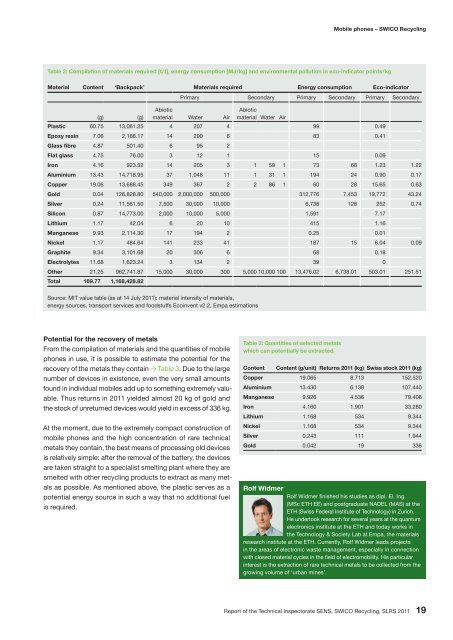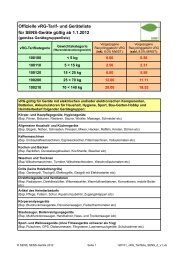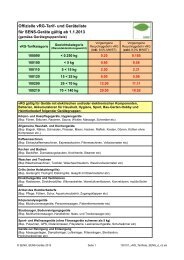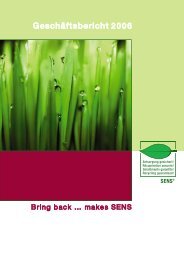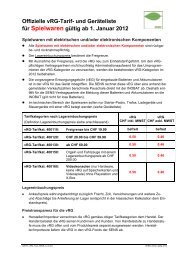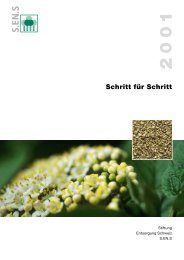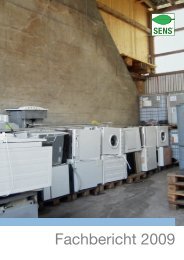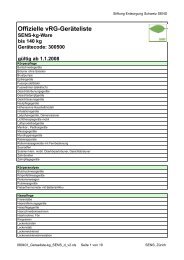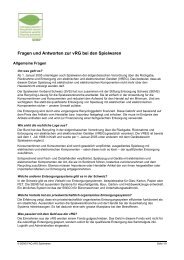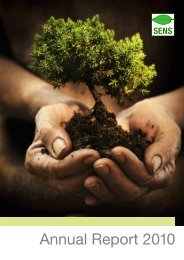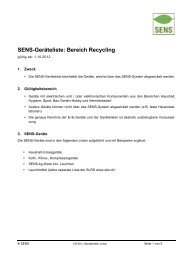Report of the Technical Inspectorate SENS, SWICO Recycling, SLRS
Report of the Technical Inspectorate SENS, SWICO Recycling, SLRS
Report of the Technical Inspectorate SENS, SWICO Recycling, SLRS
Create successful ePaper yourself
Turn your PDF publications into a flip-book with our unique Google optimized e-Paper software.
Mobile phones – <strong>SWICO</strong> <strong>Recycling</strong><br />
Table 2: Compilation <strong>of</strong> materials required [t / t], energy consumption [MJ / kg] and environmental pollution in eco-indicator points / kg<br />
Material Content ‘Backpack’ Materials required Energy consumption Eco-indicator<br />
Primary Secondary Primary Secondary Primary Secondary<br />
Abiotic<br />
Abiotic<br />
(g) (g) material Water Air material Water Air<br />
Plastic 60.75 13,061.25 4 207 4 99 0.49<br />
Epoxy resin 7.06 2,188.17 14 290 6 83 0.41<br />
Glass fibre 4.87 501.40 6 95 2<br />
Flat glass 4.75 76.00 3 12 1 15 0.09<br />
Iron 4.16 923.52 14 205 3 1 59 1 73 68 1.23 1.22<br />
Aluminium 13.43 14,718.95 37 1,048 11 1 31 1 194 24 0.90 0.17<br />
Copper 19.06 13,688.45 349 367 2 2 86 1 60 28 15.65 0.63<br />
Gold 0.04 126,828.80 540,000 2,000,000 500,000 312,776 7,453 19,772 43.24<br />
Silver 0.24 11,561.50 7,500 30,000 10,000 6,738 128 252 0.74<br />
Silicon 0.87 14,773.00 2,000 10,000 5,000 1,591 7.17<br />
Lithium 1.17 42.04 6 20 10 415 1.16<br />
Manganese 9.93 2,114.30 17 194 2 0.25 0.01<br />
Nickel 1.17 484.64 141 233 41 187 15 6.04 0.09<br />
Graphite 9.34 3,101.68 20 306 6 68 0.18<br />
Electrolytes 11.68 1,623.24 3 134 2 39 0<br />
O<strong>the</strong>r 21.25 962,741.87 15,000 30,000 300 5,000 10,000 100 13,476.02 6,738.01 503.01 251.51<br />
Total 169.77 1,168,428.82<br />
Source: MIT value table (as at 14 July 2011): material intensity <strong>of</strong> materials,<br />
energy sources, transport services and foodstuffs Ecoinvent v2.2, Empa estimations<br />
Potential for <strong>the</strong> recovery <strong>of</strong> metals<br />
From <strong>the</strong> compilation <strong>of</strong> materials and <strong>the</strong> quantities <strong>of</strong> mobile<br />
phones in use, it is possible to estimate <strong>the</strong> potential for <strong>the</strong><br />
recovery <strong>of</strong> <strong>the</strong> metals <strong>the</strong>y contain � Table 3. Due to <strong>the</strong> large<br />
number <strong>of</strong> devices in existence, even <strong>the</strong> very small amounts<br />
found in individual mobiles add up to something extremely valuable.<br />
Thus returns in 2011 yielded almost 20 kg <strong>of</strong> gold and<br />
<strong>the</strong> stock <strong>of</strong> unreturned devices would yield in excess <strong>of</strong> 336 kg.<br />
At <strong>the</strong> moment, due to <strong>the</strong> extremely compact construction <strong>of</strong><br />
mobile phones and <strong>the</strong> high concentration <strong>of</strong> rare technical<br />
metals <strong>the</strong>y contain, <strong>the</strong> best means <strong>of</strong> processing old devices<br />
is relatively simple: after <strong>the</strong> removal <strong>of</strong> <strong>the</strong> battery, <strong>the</strong> devices<br />
are taken straight to a specialist smelting plant where <strong>the</strong>y are<br />
smelted with o<strong>the</strong>r recycling products to extract as many metals<br />
as possible. As mentioned above, <strong>the</strong> plastic serves as a<br />
potential energy source in such a way that no additional fuel<br />
is required.<br />
Table 3: Quantities <strong>of</strong> selected metals<br />
which can potentially be extracted.<br />
Content Content (g/unit) Returns 2011 (kg) Swiss stock 2011 (kg)<br />
Copper 19.065 8.713 152.520<br />
Aluminium 13.430 6.138 107.440<br />
Manganese 9.926 4.536 79.408<br />
Iron 4.160 1.901 33.280<br />
Lithium 1.168 534 9.344<br />
Nickel 1.168 534 9.344<br />
Silver 0.243 111 1.944<br />
Gold 0.042 19 336<br />
Rolf Widmer<br />
Rolf Widmer finished his studies as dipl. El. Ing.<br />
(MSc ETH EE) and postgraduate NADEL (MAS) at <strong>the</strong><br />
ETH (Swiss Federal Institute <strong>of</strong> Technology) in Zurich.<br />
He undertook research for several years at <strong>the</strong> quantum<br />
electronics institute at <strong>the</strong> ETH and today works in<br />
<strong>the</strong> Technology & Society Lab at Empa, <strong>the</strong> materials<br />
research institute at <strong>the</strong> ETH. Currently, Rolf Widmer leads projects<br />
in <strong>the</strong> areas <strong>of</strong> electronic waste management, especially in connection<br />
with closed material cycles in <strong>the</strong> field <strong>of</strong> electromobility. His particular<br />
interest is <strong>the</strong> extraction <strong>of</strong> rare technical metals to be collected from <strong>the</strong><br />
growing volume <strong>of</strong> ‘urban mines’.<br />
<strong>Report</strong> <strong>of</strong> <strong>the</strong> <strong>Technical</strong> <strong>Inspectorate</strong> <strong>SENS</strong>, <strong>SWICO</strong> <strong>Recycling</strong>, <strong>SLRS</strong> 2011 19


